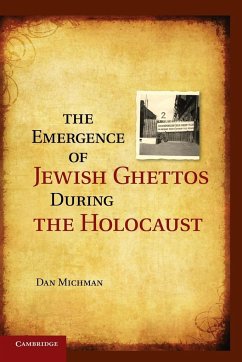Dan Michman
The Emergence of Jewish Ghettos During the Holocaust
28,99 €
inkl. MwSt.
Versandfertig in 1-2 Wochen

14 °P sammeln
Dan Michman
The Emergence of Jewish Ghettos During the Holocaust
- Broschiertes Buch
- Merkliste
- Auf die Merkliste
- Bewerten Bewerten
- Teilen
- Produkt teilen
- Produkterinnerung
- Produkterinnerung
This is a linguistic-cultural study of the emergence of Jewish ghettos during the Holocaust.
Andere Kunden interessierten sich auch für
![The Emergence of Jewish Ghettos During the Holocaust The Emergence of Jewish Ghettos During the Holocaust]() Dan MichmanThe Emergence of Jewish Ghettos During the Holocaust109,99 €
Dan MichmanThe Emergence of Jewish Ghettos During the Holocaust109,99 €![Pliny the Elder and the Emergence of Renaissance Architecture Pliny the Elder and the Emergence of Renaissance Architecture]() Peter Fane-SaundersPliny the Elder and the Emergence of Renaissance Architecture183,99 €
Peter Fane-SaundersPliny the Elder and the Emergence of Renaissance Architecture183,99 €![Asia, Europe, and the Emergence of Modern Science Asia, Europe, and the Emergence of Modern Science]() Asia, Europe, and the Emergence of Modern Science38,99 €
Asia, Europe, and the Emergence of Modern Science38,99 €![The Emergence of Détente in Europe The Emergence of Détente in Europe]() Arne HofmannThe Emergence of Détente in Europe79,99 €
Arne HofmannThe Emergence of Détente in Europe79,99 €![The Emergence of Détente in Europe The Emergence of Détente in Europe]() Arne HofmannThe Emergence of Détente in Europe206,99 €
Arne HofmannThe Emergence of Détente in Europe206,99 €![The Emergence of Meiji Japan The Emergence of Meiji Japan]() The Emergence of Meiji Japan52,99 €
The Emergence of Meiji Japan52,99 €![The Hindu Family and the Emergence of Modern India The Hindu Family and the Emergence of Modern India]() Eleanor NewbiginThe Hindu Family and the Emergence of Modern India40,99 €
Eleanor NewbiginThe Hindu Family and the Emergence of Modern India40,99 €-
-
-
This is a linguistic-cultural study of the emergence of Jewish ghettos during the Holocaust.
Hinweis: Dieser Artikel kann nur an eine deutsche Lieferadresse ausgeliefert werden.
Hinweis: Dieser Artikel kann nur an eine deutsche Lieferadresse ausgeliefert werden.
Produktdetails
- Produktdetails
- Verlag: Cambridge University Press
- Seitenzahl: 200
- Erscheinungstermin: 14. April 2014
- Englisch
- Abmessung: 229mm x 152mm x 11mm
- Gewicht: 298g
- ISBN-13: 9781107437128
- ISBN-10: 1107437121
- Artikelnr.: 41374778
- Herstellerkennzeichnung
- Libri GmbH
- Europaallee 1
- 36244 Bad Hersfeld
- gpsr@libri.de
- Verlag: Cambridge University Press
- Seitenzahl: 200
- Erscheinungstermin: 14. April 2014
- Englisch
- Abmessung: 229mm x 152mm x 11mm
- Gewicht: 298g
- ISBN-13: 9781107437128
- ISBN-10: 1107437121
- Artikelnr.: 41374778
- Herstellerkennzeichnung
- Libri GmbH
- Europaallee 1
- 36244 Bad Hersfeld
- gpsr@libri.de
Dan Michman is Professor of Modern Jewish History and Chair of the Arnold and Leona Finkler Institute of Holocaust Research at Bar-Ilan University, Ramat-Gan. He is Chief Historian at the Yad Vashem International Institute of Holocaust Research. His work has been published in 11 languages and deals with modern Jewish history and the history of Dutch Jewry, with a focus on the Holocaust. His books include Bimay Shoa Ufkuda (Days of Holocaust and Reckoning), Het Liberale Jodendom in Nederland, 1929-1943 (Liberal Jewry in the Netherlands 1929-1943), and Holocaust Historiography: A Jewish Perspective: Conceptualizations, Terminology, Approaches and Fundamental Issues, and he is co-author of Pinkas: Geschiedenis van de joodse gemeenschap in Nederland (Pinkas: The History of the Jewish Community in the Netherlands). Volumes he has edited include Post-Ziyonut ve-Shoa (Post-Zionism and the Holocaust); Belgium and the Holocaust: Germans, Belgians, Jews; Les intellectuels face à l'affaire Dreyfus: alors et aujourd'hui (Intellectuals Responding to the Dreyfus Affair: Then and Now; co-edited with Roselyne Koren); Remembering the Holocaust in Germany, 1945-2000: German Strategies and Jewish Responses; Encyclopedia of the Righteous Among the Nations: Belgium; Hashoa Bahistoriya Hayehudit: Historiografiya, Toda'a u-Farshanut (The Holocaust in Jewish History: Historiography, Consciousness, Interpretations); and Holocaust Historiography in Context: Emergence, Challenges, Polemics and Achievements (co-edited with David Bankier).
Introduction; 1. Historiography and popular understandings; 2. 'Ghetto':
the source of the term and the phenomenon in the early modern era; 3.
'Ghetto' and 'ghettoization' as cultural concepts in the modern age; 4. The
Nazis' anti-Jewish policy in the 1930s and the question of Jewish
residential districts; 5. First references to the term 'ghetto' in the
discourse of the makers of anti-Jewish policies in the Third Reich
(1933-8); 6. The semantic turning point in the meaning of 'ghetto':
Peter-Heinz Seraphim and Das Judentum in osteuropäischen Raum (1938); 7.
The invasion of Poland and the emergence of the 'classic' ghettos; 8.
Methodological interlude: the term 'ghettoization' and its use during the
Holocaust itself and later scholarship; 9. Would the idea spread to other
places? Amsterdam 1941, the only attempt to establish a ghetto west of
Poland; 10. Ghettos during the final solution, 1941-3: the territories
occupied in Operation Barbarossa; 11. Ghettos during the final solution
outside the occupied Soviet Union: Poland, Theresienstadt, Amsterdam,
Transnistria, Salonika and Hungary; Summary and conclusion.
the source of the term and the phenomenon in the early modern era; 3.
'Ghetto' and 'ghettoization' as cultural concepts in the modern age; 4. The
Nazis' anti-Jewish policy in the 1930s and the question of Jewish
residential districts; 5. First references to the term 'ghetto' in the
discourse of the makers of anti-Jewish policies in the Third Reich
(1933-8); 6. The semantic turning point in the meaning of 'ghetto':
Peter-Heinz Seraphim and Das Judentum in osteuropäischen Raum (1938); 7.
The invasion of Poland and the emergence of the 'classic' ghettos; 8.
Methodological interlude: the term 'ghettoization' and its use during the
Holocaust itself and later scholarship; 9. Would the idea spread to other
places? Amsterdam 1941, the only attempt to establish a ghetto west of
Poland; 10. Ghettos during the final solution, 1941-3: the territories
occupied in Operation Barbarossa; 11. Ghettos during the final solution
outside the occupied Soviet Union: Poland, Theresienstadt, Amsterdam,
Transnistria, Salonika and Hungary; Summary and conclusion.
Introduction; 1. Historiography and popular understandings; 2. 'Ghetto':
the source of the term and the phenomenon in the early modern era; 3.
'Ghetto' and 'ghettoization' as cultural concepts in the modern age; 4. The
Nazis' anti-Jewish policy in the 1930s and the question of Jewish
residential districts; 5. First references to the term 'ghetto' in the
discourse of the makers of anti-Jewish policies in the Third Reich
(1933-8); 6. The semantic turning point in the meaning of 'ghetto':
Peter-Heinz Seraphim and Das Judentum in osteuropäischen Raum (1938); 7.
The invasion of Poland and the emergence of the 'classic' ghettos; 8.
Methodological interlude: the term 'ghettoization' and its use during the
Holocaust itself and later scholarship; 9. Would the idea spread to other
places? Amsterdam 1941, the only attempt to establish a ghetto west of
Poland; 10. Ghettos during the final solution, 1941-3: the territories
occupied in Operation Barbarossa; 11. Ghettos during the final solution
outside the occupied Soviet Union: Poland, Theresienstadt, Amsterdam,
Transnistria, Salonika and Hungary; Summary and conclusion.
the source of the term and the phenomenon in the early modern era; 3.
'Ghetto' and 'ghettoization' as cultural concepts in the modern age; 4. The
Nazis' anti-Jewish policy in the 1930s and the question of Jewish
residential districts; 5. First references to the term 'ghetto' in the
discourse of the makers of anti-Jewish policies in the Third Reich
(1933-8); 6. The semantic turning point in the meaning of 'ghetto':
Peter-Heinz Seraphim and Das Judentum in osteuropäischen Raum (1938); 7.
The invasion of Poland and the emergence of the 'classic' ghettos; 8.
Methodological interlude: the term 'ghettoization' and its use during the
Holocaust itself and later scholarship; 9. Would the idea spread to other
places? Amsterdam 1941, the only attempt to establish a ghetto west of
Poland; 10. Ghettos during the final solution, 1941-3: the territories
occupied in Operation Barbarossa; 11. Ghettos during the final solution
outside the occupied Soviet Union: Poland, Theresienstadt, Amsterdam,
Transnistria, Salonika and Hungary; Summary and conclusion.







